
As a kid, I loved nothing more than convincing my neighbour to let me play their Amiga 500.
Ok, I’m sure there were things I loved more than that, but you see what I’m getting at.
The small amount of time I spent with the classic PC left me wanting more, and luckily, I didn’t have to look too far to get my fix. The Amiga was, obviously, quite the success in Europe, and although I’m not too sure how it fared here in Australia, I’d be willing to bet it was popular enough.
At least using the old “I knew tonnes of people with one” litmus test.
The Mega Drive was also rather popular in Europe (and Australia), and it utilised the same Motorola 68000 CPU that was found in the Amiga, so there were similarities in their architecture. This naturally lead to some Amiga games turning up on SEGA’s 16-bit hardware, and vice-versa. They weren’t all fantastic, but the ones I did play as kid me were close enough to the real deal that I couldn’t really see that much of a difference. Now that I’m older, the differences are easier to spot.
So here’s a bit of a list.
These are ports from the Amiga to the Mega Drive, the Mega Drive to the Amiga or are just simply games that SCREAM Euro-PC.
Either way, here are 5 MEGA DRIVE GAMES with that AMIGA-kinda flavour.
LEGEND OF GALAHAD:

The Legend of Galahad is a game that I didn’t know about until I discovered emulation.
Thank you, KGen 98!
I had no idea that its original form was Leander on the Amiga, but looking back on it, all the signs were there. That distinctive pixel-art style. Those haunting melodies. Yep, looking back on it, TLoG is perhaps one of the best examples of the Amiga game as interpreted by the humble Mega Drive.
At its core, it’s a basic action-platformer – nothing more, nothing less. You’ll work your way through each map looking for keys to open up the exit to the next level, and as you parade around in your weird head-gear, you’ll be assaulted by enemies left, right and centre and visit shops to upgrade your stuffs. Indeed, if I had to liken it to anything, it’d be the Wonder Boy in Monster Whatever games. It’s got the same hacky-hacky/slashy-slashy combat, but with a more linear level-progression system and that oh-so-delicious Euro-flair.
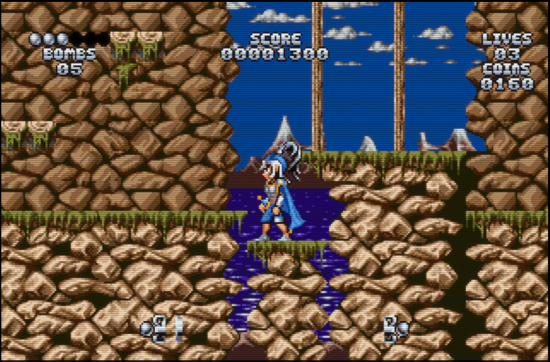
The levels can become rather large and sprawling too, and the path to finding the key to open the exit is rarely ever straight-forward. You’ll be sending Galahad/Leander into caves, up waterfalls and through temples/castles and other medieval clichés in search of these keys, and although it’s all fairly basic, it’s in the execution that the game really succeeds. Each level is varied enough to feel like you’re not repeating the same thing over and over, and the combat system is definitely engaging. Movement controls, too, are pitch-perfect. I found myself traversing the landscapes and set pieces without too much trouble.
Much less fun is the collision detection. It’s alright, and nothing is out-right broken, but there are definitely times you’ll be thinking ‘faaaark. I swear that bat didn’t touch me…’
There’s also some rather obnoxious level hazards to contend with. Choice design decisions include spikes that jut out of the ground from absolutely nowhere, and boulders that fall from the sky.

Still, the Audio/Visual side of things help gloss over smaller niggles. The graphics in this one seem a little improved over the Amiga original, truth be told. The backgrounds contain more art, and the colour count in both the character Galahad and the enemies seems more varied, as do some of the environments. It’s a bit of a two-way-street thing though, as Leander on the Amiga features some of those really neat – and distinctive – sky gradients the platform was famous for.
I think taking into account these small differences, each version looks as good as the other. Both feature some gorgeous animation on the main sprite, and the work put into the background tiles is exceptional. Enemies in the game are a little more static, but it’s hard to complain when it all looks this nice.
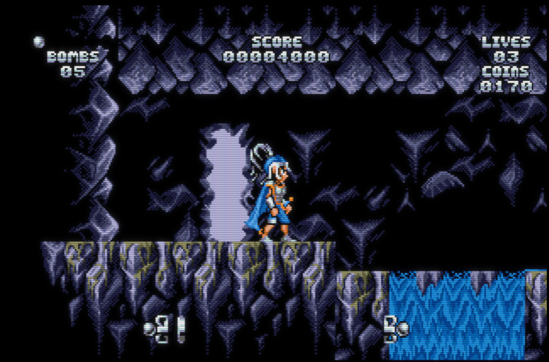
The music in TLoG is also brilliant. The original Amiga soundtrack was composed by Tim Wright and Matthew Simmonds, and their work was ported faithfully over to the Mega Drive by none other than Matt Furniss. I do prefer the slightly crisper sound of the Mega Drive port, but both are phenomenal – full of pretty melodies and a real sense of adventure. Sound effects are serviceable, but I don’t doubt for a second that it’s the music that’ll stick with you the most.
TLoG is not a flawless game, but it is one of my Top 5 Mega Drive games. It’s short enough to clock in an afternoon, the gameplay is fun, and the A/V presentation oozes late-80s Europe.
Highly recommended, and definitely one of the best Amiga-to-Mega Drive conversions you’re likely to find.
BRAM STOKER’S DRACULA:

Now, this one I DID play as a kid. First on the Amiga, and then on the Mega Drive. I am a massive fan of the titular movie, and as a wee lad, I pored over any and all Dracula coverage I managed to stumble across in magazines. I think I even made a Dracula scrap-book.
I had assumed the Mega Drive game was a port of an Amiga original, but that turned out not to be the case – if anything, the Amiga version was the bastard-child of this Mega Drive incarnation and the awful MEGA CD game.
All you really need to know is that Bram Stoker’s DRACULA on the Mega Drive is basically TLoG in a different skin.

Let’s count the ways.
- The gameplay is nigh-on identical to TLoG, but shorter and more linear than before.
- The music is another Matt Furniss masterpiece.
- It even contains the same goddamned spike level hazards as TLoG.
- The graphics are very similar too – as you can clearly see in the screenshots I’ve attached. The animation is even better this time around, though.
The formula works, and I like it.
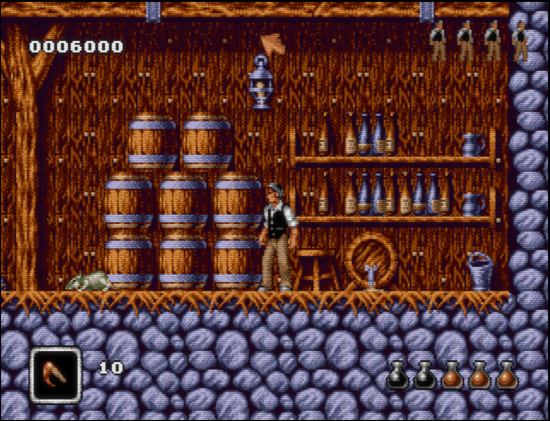
I reckon that if you enjoy TLoG, then you’ll enjoy Dracula too. The game hits the same highs and lows, and the links to the film are tenuous and surface-level at best, but it still gives the game a different vibe, and again, it’s one of my favourite games on the system.
Nothing spectacular (…) then, but it’s well made, and perfectly serviceable to the most casual of players.
Argh, this is killing me.
I’m trying so hard not to oversell the game here. If I had my way, I’d stand atop the tallest mountain I could find and shout my (perhaps) misplaced love for the game to all you denizens below.
I love this game. A LOT.
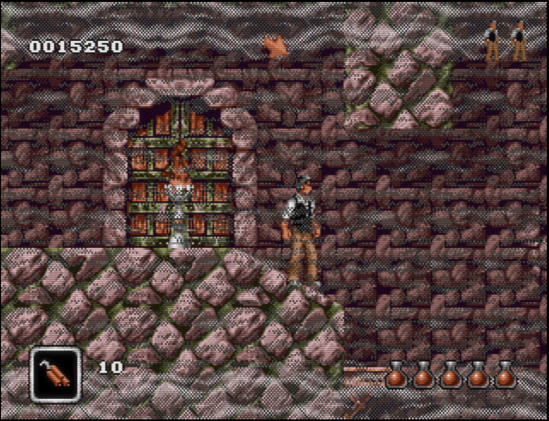
I’d take it over any Mario game, and it’s up there with the more socially acceptable classics on the Mega Drive for me. I make no apologies for that.
I am, however, acutely aware of its flaws, and I know it’ll only ever be a cheap Movie tie-in with no personality to many. I’d argue the personality bit, but I’ll also concede that yes, it’s a licensed movie-game. It was even probably a ‘pay-check’ kinda game.
I don’t care though – it’s awesome. I like to think that I’m fairly impartial, and what flies for me won’t necessarily float everybody’s boat, so I won’t recommend Dracula as blindly as I did the previous game. But if you want an Amiga-style game that is actually more Amiga than the actual Amiga game, then Jonathan Keanu Harker is your dude. Shite boss-battles aside, Dracula is a platformer, and it works.
A dime-a-dozen, as that familiar trope goes, but still a joy to play.
You may just dig it as much as I do.
MEGA TURRICAN.
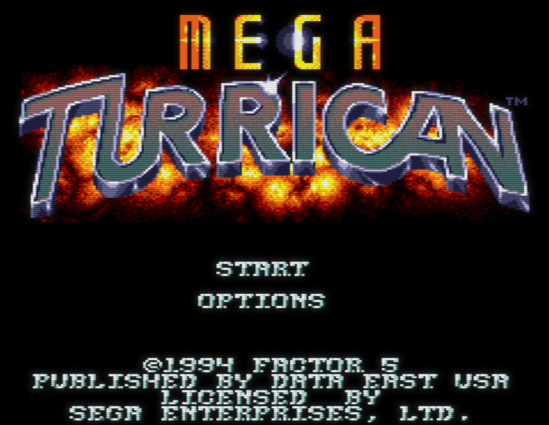
I was considering not covering Mega Turrican here, because it’s a brilliant game, and a known-quantity at that, but far out.
That guilt, man, that guilt.
Mega Turrican is an odd one, as its lead platform was the Mega Drive, and the subsequent port to the Amiga ruffled a few feathers back in the day. The series was known as being one of the Amiga’s crown-jewels, and fans of that platform in the early 90s must have seen this as a betrayal of the highest order.
At least, that’s how I’ve seen it play out…
…check out any YouTube video comparing the Amiga music with the Mega Drive version, and you’ll see what I mean.
And a younger me probably would have at least empathized, if not agreed with them. If, y’know, I happened to grow up with an Amiga as my main. But I didn’t. And I think Mega Turrican is the best in the series.
There’s not much else to say about this one that hasn’t already been said. Turrican was always Europe’s kinda-sorta equivalent to Contra. A killer run-and-gun with less cut-and-dried level design, and more Chris Huelsbeck. Can never have enough Chris Huelsbeck. In anything.

And whilst I never loved Contra, I’ve always loved Turrican.
The maps are huge, the controls are as tight and reliable as they come, and it throws a tonne of enemies at you in any given moment. Each stage looks different, so it never becomes a chore to play – even when you’re being pummelled from every angle and have to start over because you died and you’re shit at games and you have to lower the difficulty level.
Ahem.
Graphically, Mega Turrican stands as a great testament to the power of the Mega Drive. There’s something honorable in picking a lane you’re good at, and nailing the execution. What Factor 5 achieved here isn’t always full of the most incredible trickery, but what they do manage to pull-off is executed flawlessly. The colours are bold, rich and many, the scrolling smooth and the sheer variety of things to see and blow up in each stage is staggering. Superior to the Amiga version then, with more detail in the backgrounds and more animated background elements, but that’s not entirely surprising – this being the lead platform and all.
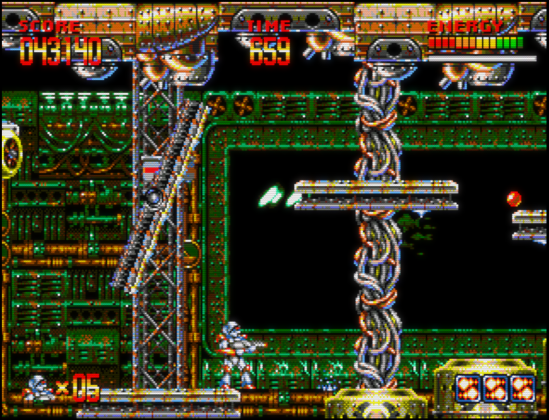
The sound work is much the same. High quality, and just nailed down so hard. I am a massive fan of MOD music, but I think that in this particular case, the crisp FM and high-quality drum samples sound better on the Mega Drive than the Amiga, which to my ear at least, sounds a little thin in regards to instrumentation.
This isn’t a one-way conversation though. This neat video I found will allow you to make up your own mind on the matter.
Which one do YOU think sounds better? Sound off in the comments below.
But be warned.
If your answer is something along the lines of “Hahaha, OMG, X version is SO SHIT because I grew upwiththisandmyopinionistheonlycorrectone,. ZOMGXDDDPEASANTS!!!”, then know that I’ll be sitting here, laughing at you. Likely for the rest of the evening.
So yeah. Mega Turrican. It’s one of a rarer breed- the Mega Drive to Amiga conversion -and utterly brilliant to boot. Buy 10 of them.
THE MISADVENTURES OF FLINK.
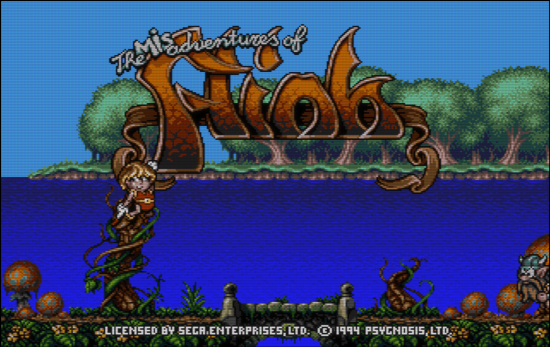
This is one Mega Drive game I never owned. I rented the shit out of it though, and again – I’m sensing a theme here – it’s one of my favourite games on the 16-Bit console.
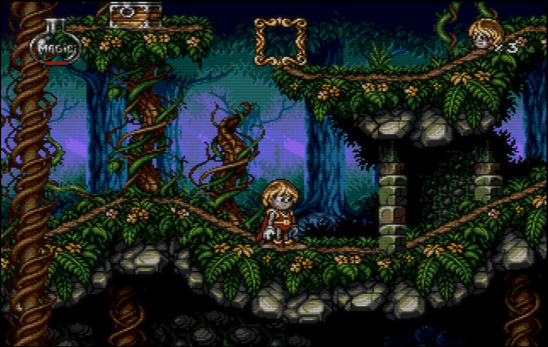
The Misadventures of Flink is a little different. It’s a puzzle-platformer with a heavy emphasis on the platforming. It also lays the charm on thick with it’s cute characters and twee personality. There’s definitely some funky momentum going on with Flink’s run, but it’s predictable, and when you acclimate to it you’ll be treated to perhaps one of the best platformers on the system.

Each level is a fun romp through gorgeous fantasy environments, and are almost little mini-challenges in themselves. The game can get pretty damned tough, I gotta say. Stick with it though – if you memorize a level, you’ll definitely be better off.

You don’t need me to tell you how gorgeous it is. With art by the talented HOLDMECLOSERHENKNIEBORG, it’s like the cover of a fantasy novel come to life. The Mega Drive could only technically display 64 colours at a time, but tell that to Henk! I mean, yeah, he was stuck with the same limitations as everybody else, but man, he knows how to work those palettes. The music is just as fantastic, with only some occasionally suspect instrumentation letting that side of things down. The compositions themselves are great. Catchy, bubbly and it really helps sell the atmosphere.

Flink released on the Mega CD too, as well as the Amiga CD32. I have no idea which version was the lead platform, but I’ll take a stab in the dark and say the CD versions of Flink were the leads, and the Mega Drive game was the pared back one. In saying that, I can’t say I’ve noticed too many differences between them all – some CD audio here, an intro sequence there – but no matter what version you settle on, then rest assured. If Flink catches you in the right mood, you’ll never let it go.
Here.
Have another image.
Just because.
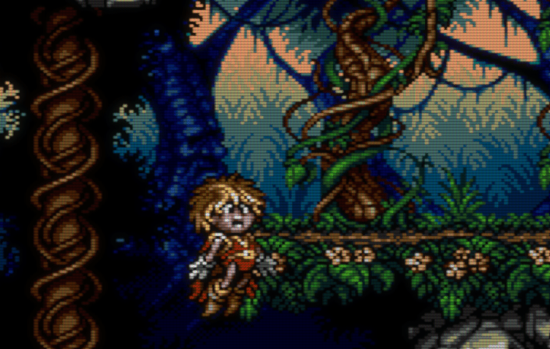
LOTUS II: RECS

Because you just know I had to throw an arcade racer into the mix.
If you’ve never played a Lotus game, then I really feel for you. Playing it more straight than Outrun ever did, the Lotus series is a fantastic set of 2D raster-racers that lead the genre, at least in Europe. On the Amiga, they were fast, gorgeous, and smoother than your average racing title. Killer music too!

My first Lotus experience was actually with Lotus III: The Ultimate Challenge at a mates place on an old 486 PC. We played two-player for ages, and I knew I needed the game. So I found Lotus II: RECS on the Mega Drive, and was similarly impressed. I didn’t realise it at the time, but RECS was indeed a port Lotus III, so it’s no wonder it dug its claws so deep under my skin.
Time hasn’t been so kind to RECS though. The frame-rate is fairly smooth, but there is a lot of noticeable slowdown when a lot of cars and hazards are being thrown at the screen. Things are over-simplified a little too much, especially in comparison to the Amiga original. It was obviously necessary to make the cut-backs, and I don’t begrudge the developers for making the hard calls. The Mega Drive could hold it’s own in all the various platformers and action games, but games like Lotus showed that the Amiga definitely had the edge in more demanding genres, like racing games, in which it’s extra RAM – 512kb/1mb compared to the Mega Drives 64kb – was undoubtedly a big advantage.
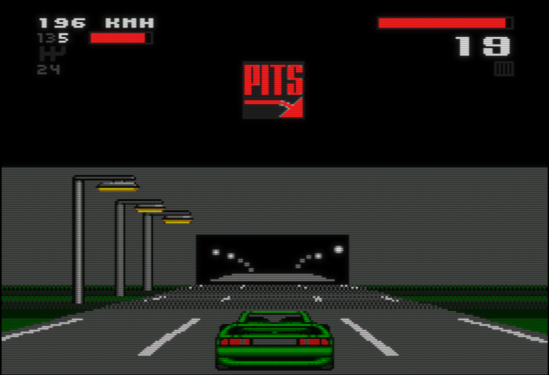
The music has unfortunately seen an even bigger down-grade than the visuals, and that says a lot about the music. The original Amiga tunes were full of amazing samples and high-quality instrumentation. The Mega Drive was no stranger to 90s electronica either – the Streets of Rage games proved that the radio-style electronica was well suited to it’s bassy FM-Synth YM2612 module – so I’m sure it could have been adapted well, given a little love and care. Alas, the music in RECS received the bare minimum of effort required of the programmers, and sounds terrible.
It’s like listening to a really shitty MIDI cover of a bangin’ house tune. Something I definitely did in the 90s.

So, yeah, all up, the port isn’t the most amazing I’ve ever seen.
If you can only play one or the other, go for the Amiga game.
If you’re still curious about RECS, then know it is still a lot of fun to play – just keep your expectations in check, and you’ll be golden. It may not have the glitz of it’s bigger, more Euro brother, but the controls are rock-solid. There’s a good game in here, and RECS offers a fairly steep challenge for any potential racer willing to give the game the time of day.
It’s a fun game, for sure. Not the best port around, but definitely worth a shot.
SAME SAME. BUT DIFFERENT.
I really made the right choice as a kid. I loved my SEGA Mega Drive, and part of the reason for that was all this cool Euro-stuff. You’d be hard-pressed to find equivalents on the likes of the SNES, and bar a game or two from this list, this is what differentiated the Mega Drive from Nintendo for me back in the day.
This is far from an exhaustive list, and I’ll revisit this topic – and some of the games I didn’t cover – someday soon, I’m sure.
Until then, I’ll keep digging into Flink. I’ve whet my appetite for it after grabbing screenshots for this post, and I can hear it calling me back…
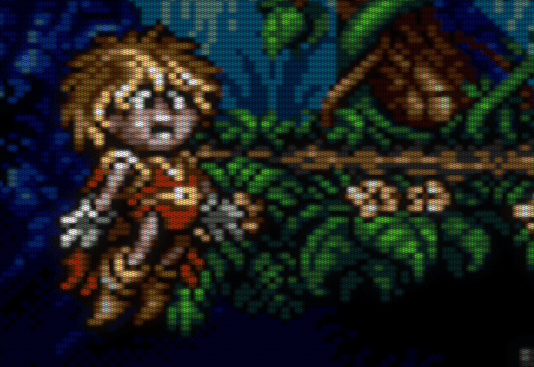
Tags: 16-Bit, Amiga, Amiga CD32, Arcade Racer, Australia, Blog, Bram Stoker's DRACULA, Chris Huelsbeck, collectors, Dracula, emulation, Europe, Flink, Galahad, gamer, Games, gaming, Genesis, Henk Nieborg, Leander, list, Listicle, lists, Lotus, Lotus Games, Lotus II: RECS, Lotus III: The Ultimate Challenge, Matt Furniss, Mega CD, Mega Drive, Mega Turrican, Movie Licensed Games, Platformers, Puzzle Platformer, Retro, Run and Gun, SEGA, The Legend of Galahad, The Misadventures of Flink, Tim Wright, Top 5s, Turrican, Video Games, YM2612
